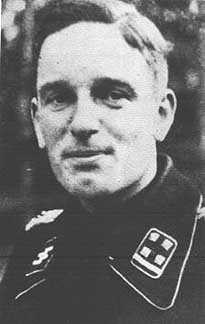Hans Albin Freiherr von Reitzenstein
| Hans Albin Freiherr von Reitzenstein | |
|---|---|
 | |
| Born |
4 March 1911 Berlin, Germany |
| Died |
30 November 1943 (aged 32) Russia |
| Allegiance |
|
| Service/branch |
|
| Years of service | 1931–43 |
| Rank | Obersturmbannführer |
| Unit |
Leibstandarte SS Adolf Hitler Wiking Division Das Reich |
| Battles/wars | World War II |
| Awards |
Knight's Cross of the Iron Cross Iron Cross 1st Class Iron Cross 2nd Class Eastern Front Medal Panzer Badge Wound Badge |
Hans Albin, Freiherr von Reitzenstein (4 March 1911 — 30 November 1943) was an Obersturmbannführer (Lieutenant Colonel), in the Waffen SS during World War II who was awarded the Knight's Cross of the Iron Cross, which was awarded to recognize extreme battlefield bravery or successful military leadership by Nazi Germany during World War II.
Early life
Hans Albin Freiherr von Reitzenstein was born in Berlin on 4 March 1911. He joined the Allegemeine-SS in 1931 and transferred to Leibstandarte in 1933.
World War II
Von Reitzenstein was transferred to the SS-VT for the Polish Campaign in command of the 1st Company, SS Infantry Regiment Deutschland (2nd SS Division Das Reich). He was wounded during the Polish Campaign and was posted to the SS-Junkerschule at Bad Tolz to recover.
In December 1940 von Reitzenstein was posted to the newly formed SS Wiking Division that was being formed from an influx of foreign volunteers, particularly from Denmark, Belgium, the Netherlands and Norway. He was the commander of its 5th Reconnaissance Battalion. In 1942 he was transferred to the Das Reich Division and assumed command of the 2nd SS Reconnaissance Battalion, which was stationed in Russia. He remained in command of the Reconnaissance Battalion until March 1943, when he replaced Herbert Ernst Vahl as the commander of the 2nd SS Panzer Regiment.
Von Reitzenstein, promoted to Obersturmbannführer, was in command of the Panzer Regiment for the Battle of Kursk (Operation Citadel), during which he was awarded the Knight's Cross for the Regiment's actions at Belgorod, the Mius, Kharkov and Kolomak, when it destroyed 839 tanks, 18 assault guns, 334 anti-tank weapons and 32 other guns.
Hans Albin Freiherr von Reitzenstein committed suicide on 30 November 1943, due to the events surrounding the death of a female Russian volunteer (see Hiwi for SS volunteer system).
At the time of his death von Reitzenstein had been recommended for the German Cross in Gold.
Ranks and promotions
| Reitzenstein's SS-ranks | |
|---|---|
| Date | Rank |
| 1 October 1933 | Untersturmführer |
| 4 July 1934 | Obersturmführer |
| 4 July 1936 | Hauptsturmführer |
| 1 September 1941 | Sturmbannführer |
| 20 April 1943 | Obersturmbannführer |
References
- Mattson, Gregory SS-The realm. The History of the Second SS division, 1939-45. Staplehurst 2002, ISBN 1-86227-144-5
- Fellgiebel, Walther-Peer (2000). Die Träger des Ritterkreuzes des Eisernen Kreuzes 1939–1945 – Die Inhaber der höchsten Auszeichnung des Zweiten Weltkrieges aller Wehrmachtteile [The Bearers of the Knight's Cross of the Iron Cross 1939–1945 — The Owners of the Highest Award of the Second World War of all Wehrmacht Branches] (in German). Friedberg, Germany: Podzun-Pallas. ISBN 978-3-7909-0284-6.
- Mitcham, Jr.Samuel, Retreat to the Reich, Stackpole books 2007. ISBN 0-8117-3384-X
- Henschler Henri & Fay Will, Armor Battles of the Waffen-SS, 1943-45 Stackpole Books, 2003, ISBN 0-8117-2905-2